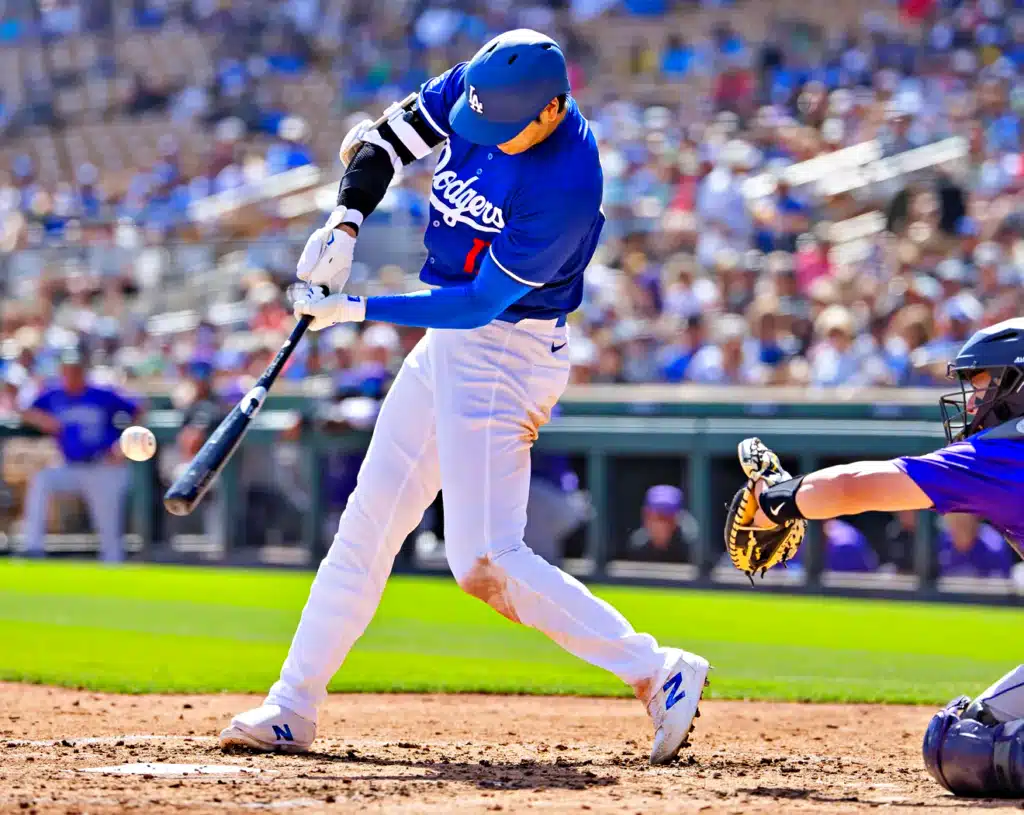
Shohei Ohtani
Ohtani averaged .293 for the month with 12 home runs, 24 RBIs, and a 1.110 OPS. Anyone else with those numbers would get a huge shout-out. For him, well, it’s getting kind of expected. Almost ho-hum.
Overall, he’s averaging .316 – his best start since he came to MLB with the Los Angeles Angels in 2018 – with 26 home runs, 62 RBI and a 1.034 OPS. After three months, he’s ahead of last year’s MVP-winning pace in batting average, hits, doubles, home runs, RBIs, total bases, stolen bases, and OPS+. His hard-hit rate and strikeout percentage – if they hold up the rest of the season – would be the best of his seven-year MLB career. His line-drive percentage is up, and his groundball percentage is down. And he’s just a shade lower than last season in on-base percentage and slugging percentage.
His 4.7 WAR figure, according to Baseball Reference, is best in the National League and third-best in MLB. He ranks second in MLB in batting average and OPS, and he’s third in home runs.
Against the Chicago Cubs on June 26, his leadoff home run marked the 10th consecutive game in which he had at least one RBI, a Dodger club record.
The only wart on his record is that he’s had less success than expected with runners in scoring position (RISP); From 2021 to 2023, Ohtani was one of Major League Baseball’s best hitters with RISP. He batted .305 in those situations, the 22nd-best mark in the majors in that span. At the of June, according to FanGraphs, he was hitting .244 in those situations with one home run and 27 RBIs. He was averaging .329 with the bases empty and .310 with runners on base but not in scoring position.
Ohtani, of course, is not pitching this year because of off-season Tommy John surgery, and that may be one reason he’s doing so well offensively.
“I think it’s unquestionable that I’m able to recover properly because there’s less of a workload,” Ohtani said in Japanese. “Plus, as I pile up experience year after year, I’m growing as a hitter. I think that’s leading to good results.”
Dodger manager Dave Roberts added, “I think Shohei understands that when you show you can control the strike zone, take balls, even in hitters’ counts, that a lot of special things happen,” Roberts said. “In years past, he had a big tendency to chase because he likes to swing. But when you [lay off bad pitches], you earn pitches in the strike zone.”
Also, check out this play that Dodger batboy Javier Herrera made on a hard-hit foul that could easily have struck Ohtani. Ohtani was getting ready to go on deck when a liner went screaming into the dugout. It looked like the ball could have hit him in the head, but Herrera casually made a barehanded catch and then just handed the ball to a fan. Ohtani later took to Instagram and called Herrera “My Hero.”
Yuki Matsui
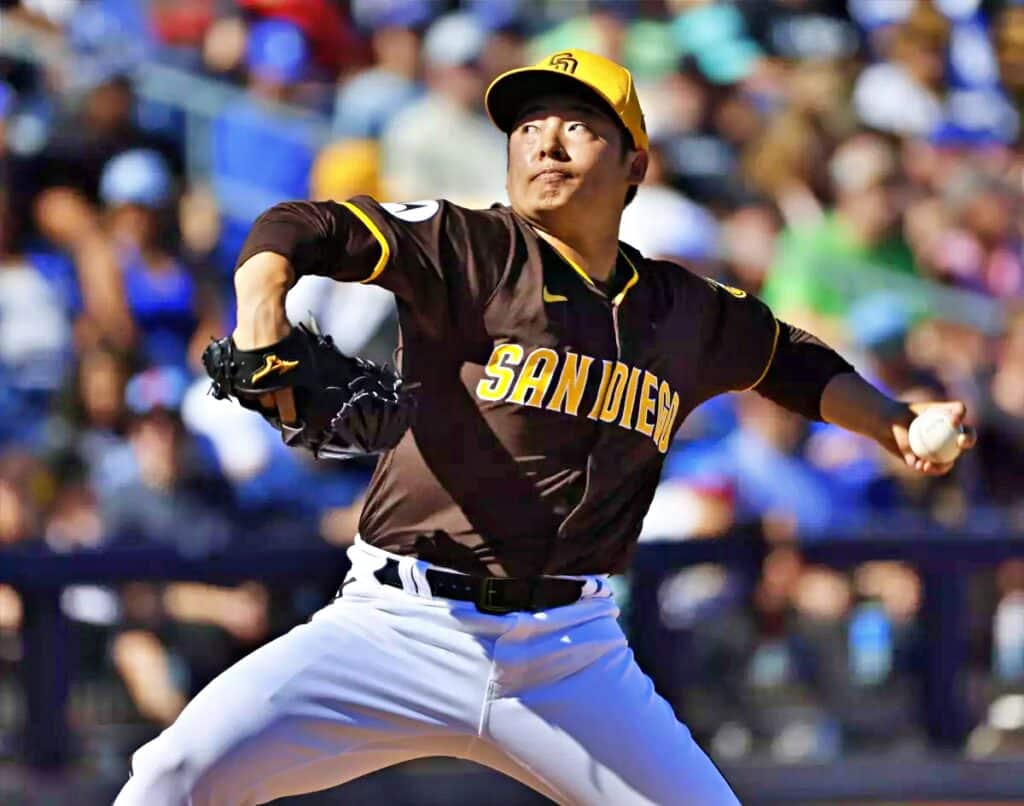
Matsui, a 28-year-old in his first MLB season, missed much of spring training with back issues, throwing only three innings, but he has been solid for the Padres in the regular season.
In May, he had a stretch of three games in which he gave up four earned runs in 2.2 innings, but he then did not allow a run in his final seven outings of the month. He began June by allowing six earned runs in just one-third of an inning over two games, but then gave up just six hits and no runs over his next 11 appearances.
At the end of June, he stands at 3-2 with a 3.50 earned-run mark. He’s given up just one home run and only 24 hits in 36 innings, although his walk rate is quite high at 5.7/9 innings. A lefthander, he’s nonetheless been tough on righthanded hitters, allowing them just a .176 average. Lefthanders, meanwhile, have hit only .217 off him.
Matsui mixes his pitches well – a fastball that ranges into the mid-90s, a splitter, curve, and slider. Reportedly, the slider averages 31 inches of vertical and 24 inches of horizontal movement.
Though Matsui was a closer in Japan, he’s been used almost entirely in setup situations with the Padres. He was put into the closer role against Kansas City on June 2 when regular closer Robert Suarez was not available and gave up three runs as the Padres lost 4-3. Matsui has actually finished five other games, but he either entered those either with the Padres losing or winning by a large margin – eliminating save situations.
Seiya Suzuki
Like Kikuchi, Suzuki took steps in the right direction during 2023 and continued to do so in April 2024 before hitting the Injured List on April 15 because of an oblique injury.
Suzuki returned to the lineup on May 11 and batted just .219 the rest of the month with only two home runs and six RBI. He did seem to pick up the pace somewhat late in the month, though, with six hits in his last 19 at-bats. In June, he averaged just .258 but slugged .505, hit five home runs, and drove in 12 runs. His seasonal slash line at the end of June was .258/.329/.454.
During his nine-season career in Japan’s Nippon Professional Baseball (NPB), he was noted for making consistent contact and getting on base a lot. He had a .402 career on-base percentage in Japan, but his corresponding mark in two-and-a-half seasons with the Cubs is .346. In Japan, he struck out in 18 percent of his at-bats. With the Cubs, the figure is 27 percent.
One report claimed that Suzuki and the Cubs’ Ian Happ are very similar players making a lot of money and that one should be traded. It also called into question Suzuki’s defense in right field.
Suzuki is in the third year of a five-year, $85 million contract he signed prior to the 2022 season.
Masataka Yoshida
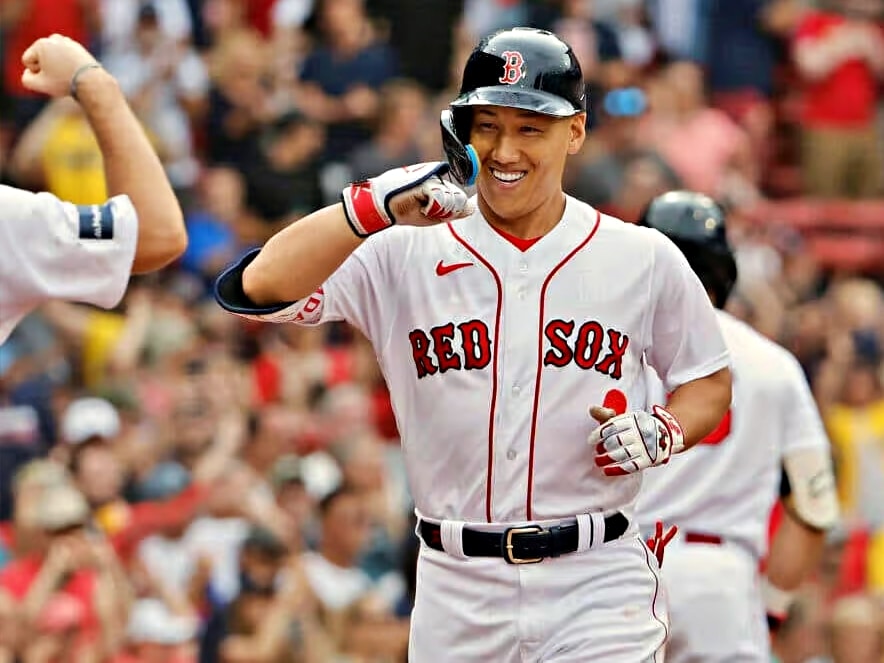
So far in 2024, Yoshida hasn’t been what the Red Sox need.
He was placed on the Injured List on April 29 with a left thumb sprain after jamming his hand during an at-bat the previous night and didn’t play again until June 11. Since returning from the IL, he has averaged only .200 with a .533 OPS, no home runs, and two RBIs. For the season, he is averaging just .246 and has a .657 OPS.
“[He’s] controlling the strike zone (but) timing is off,” manager Alex Cora said. “But we’ll take the good at-bat. It’s just a matter of time for him to start driving the ball. He’s hit some balls hard. But we’re comfortable with him.”
Yoshida has been a slow starter for much of his career, first in Japan and now in MLB, so it’s possible that his production could increase as the season goes along. But with the Red Sox having a surfeit of outfielders, along with the fact that Yoshida’s defense was sub-par in 2023, he’s been having to adjust to being mostly a designated hitter. After playing 713 innings in left field in 2023, he’s played just one inning there this season.
Signed to a five-year, $90 million contract before last season – which more than a few observers thought was an overpayment – Yoshida has yet to pay dividends.
Shōta Imanaga
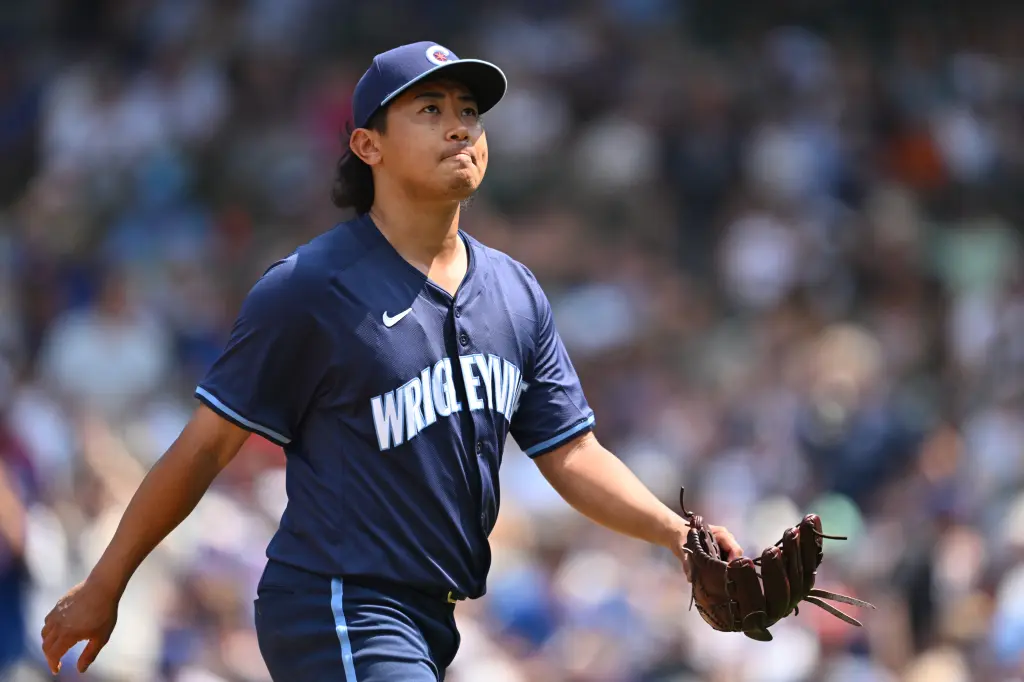
Imanaga has consistently taken the spotlight so far. As with all imports, the question was how well and quickly he could make the adjustment to MLB, and he’s answered that well, even though he stumbled somewhat in June. After being virtually unhittable in April and merely all-star caliber in May, he was 2-1 in June with a 5.67 ERA.
To be fair, three of his five starts were solid, particularly the June 15 outing against St. Louis when he gave up just a run and four hits in seven innings. But he had a couple of stinkers, too – seven hits and five earned runs in 4.1 innings against the Chicago White Sox and then a three-inning stint against the New York Mets in which he gave up 10 earned runs.
Still, Imanaga has done far better overall than perhaps anyone expected at the beginning of his MLB career. He’s 7-2 with a 3.07 ERA, and a 1.11 WHIP. He has 84 strikeouts and just 14 walks in 85 innings. Even in June, he only walked four batters in 27 innings.
“He’s been fantastic,” Cubs’ outfielder Ian Happ said after Imanaga went six innings and gave up three runs in an extra-inning win over San Francisco on June 27. “It’s been such a stabilizing force for us.”
The Cubs are 12-3 in games Imanaga has started, but they’re just 26-41 in other games.
Yusei Kikuchi
Through the first two months of the 2024 season, Kikuchi continued the improvement he’d exhibited in 2023, but his June performance was more difficult than those of April and May.
In six starts, he was 2-4 with a 6.26 earned-run mark. He had good efforts against Baltimore and Milwaukee, but in the other outings, he gave up 28 hits and 18 earned runs in just 16.1 innings.
Overall, he is 4-8 with a 4.18 ERA and is averaging just 2.1 walks per nine innings. His best mark in his previous five seasons was 2.6 per nine innings in 2023, and his MLB career average is 3.2.
Interestingly, Jim Bowden of The Athletic surveyed more than 35 MLB executives and compiled a list of the players most likely to be dealt by the upcoming trade deadline. Kikuchi is on the list.
“Kikuchi is an impending free agent and he’s had a strong season,” Bowden wrote, “posting a 3.52 FIP and 4.00 ERA over 16 starts. He’s averaged 9.3 strikeouts per nine innings and a career-low 2.1 walks per nine. His command and control have improved dramatically over the past two years. If Toronto keeps losing, the 33-year-old lefty will find himself in a new uniform come August.”
As an aside, on June 14, Kikuchi was involved in an oddball collision with Oakland A’s first baseman Tyler Soderstrom. Soderstrom was chasing a foul popup near the Blue Jays’ dugout when Kikuchi came out of the dugout and accidentally collided with him while presumably trying to get out Soderstrom’s way.
Kenta Maeda
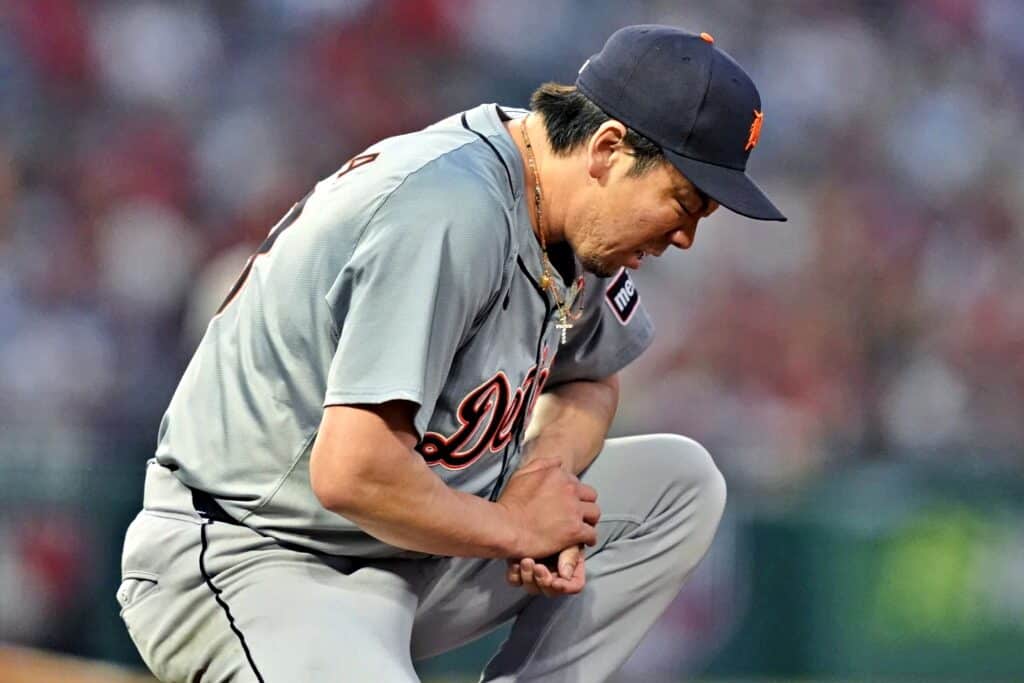
The 35-year-old Maeda signed a two-year, $24 million deal with Detroit in the off-season. The Tigers, who were 38-46 and fourth in the American League Central Division at the end of June, need him to be the pitcher he was in the second half of last season if they are to contend this year.
So far, though, it hasn’t worked out that way, though he showed flashes in May. He spent time on the Injured List in May because of a viral illness but has not often been effective.
He did reach a milestone on June 5 when he started against Texas. The appearance was the 200th of his MLB career, making him the 12th Japan-born pitcher to reach that level. He left that game after just two pitches because of abdominal discomfort but returned to make his next start on June 11.
In June, he was 0-2 with a 4.74 ERA, though he was effective in his final start against the Los Angeles – 5.1 innings, two runs, and six hits. Overall, Maeda is 2-4 with a 5.76 earned-run average. His home runs-allowed rate (1.8 per nine innings) is the highest of his career; his walk rate of 2.9/9 is one of the highest of his career; and his strikeout rate (6.8/9) is by far the lowest.
Yoshinobu Yamamoto
In the first year of a 12-year, $325 million contract, Yamamoto has been mostly effective, but he hit a bump in the road when he went on the Injured List on June 16. He had left his start against Kansas City the day before with what was first believed to be tightness in his right triceps, but it later was diagnosed as a rotator cuff strain.
Manager Dave Roberts said the MRI exam did not reveal any tears in the rotator cuff, but there is currently no timetable for Yamamoto’s return to action.
“I just think that it’s a guy that we’re still trying to learn a lot about and appreciate the fact that the most important time of the season is yet to come,” Roberts said. “And his health is paramount. So for us to be proactive and put him on the IL, kind of reset him, seems like the smartest move.”
The Dodgers had been letting him start every sixth or seventh day, as he did in Japan, and he was handling the transition well. His statistics remain good, even including his disastrous first start against the Padres in Korea.
In two June starts, plus the shortened outing against Kansas City, he allowed just 10 hits and one run in 15 innings. For the season, he’s averaging 10.2 strikeouts, 7.5 hits, 2.1 walks, and 0.7 home runs per nine innings – all outstanding marks. Opposing batters are averaging just .221 with an on-base percentage of only .266 and a .357 slugging percentage. For the season, he is 6-2 with a 2.92 ERA, and his FIP (fielding independent pitching) mark is an excellent 2.67.
Yu Darvish
After undergoing a minimally-invasive arthroscopic debridement in his pitching elbow during the offseason, he had a reasonably good, if inconsistent April, and he followed that with a very solid May. But he has had injury trouble and hasn’t pitched since May 29.
He spent 15 days on the Injured List in April because of “neck tightness” and then went back to the IL in early June because of a groin strain. He was scheduled to come off the IL on June 25, but now has inflammation in his right (pitching) elbow. Padres manager Mike Shildt said the club doesn’t believe Darvish’s latest elbow ailment is serious but is “still in the process” of determining how much time the 37-year-old is likely to miss.
Darvish is 4-3 with a 3.20 ERA and 1.07 WHIP this season. He is allowing 2.4 walks per nine innings, which, if continued throughout the season, would be the second-best mark of his career.
Kodai Senga
Senga suffered a setback early in spring training when he was diagnosed with a moderate right posterior capsule strain and received a platelet-rich plasma (PRP) injection. He was eventually placed on the 60-day IL, and he was projected to return to the mound in late May. The timetable now has been extended, as it’s likely that he will not be back before the All-Star break.
Senga said on June 25 that he expected to begin a minor-league rehab assignment the following week (the week beginning June 30), according to Anthony DiComo of MLB.com.
In 2023, the first of a five-year, $75 million deal, Senga posted a 2.98 ERA with 202 strikeouts in 166 1/3 innings. He was named an All-Star, placed second in the National League Rookie of the Year voting, and finished seventh in NL Cy Young voting.
Senga needs to pitch at least 400 innings from 2023-2025 to be able to opt out of his contract at the end of the 2025 season. At the moment, he has just the 166.2 from last season.
NOTES: Rintaro Sasaki, the high-school phenom in Japan who opted to play at Stanford University instead of going through the NPB draft, is playing for Trenton in the MLB Draft League. At the moment, he’s hitting . 271 with three home runs, 11 RBIs, and a .897 OPS through 14 games . . .
Righthanded reliever Naoyuki Uwasawa, who signed a minor-league contract in the off-season with the Tampa Bay Rays after nine seasons with the NPB’s Nippon Ham Fighters, was traded to Boston on March 28 for cash and immediately assigned to the Red Sox’ AAA Worcester, MA, affiliate. There, he is 3-3 with a 6.48 ERA. He’s made 12 appearances, six of them starts . . . Reliever Shintaro Fujinami was a late-spring demotion by the Mets. Sent to AAA Syracuse, his command issues continued, with 17 walks in 7.2 innings and a 14.09 ERA. He pitched a scoreless inning for the Met’s Class A team in Port St. Lucie (FL) has since been assigned to the Mets’ team in the Florida Complex League where he’s made one scoreless appearance thus far . . . Infielder Yoshi Tsutsugo, who had stints in the Tampa Bay, Los Angeles Dodger, Pittsburgh, and San Francisco organizations without much success, is back in Japan with his former team, the Yokohama DeNA Baystars. He’s averaged .213 with the Baystars and also appeared in six games with their minor-league affiliate.






